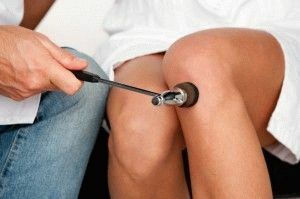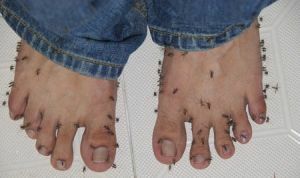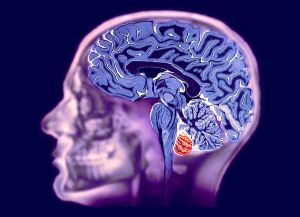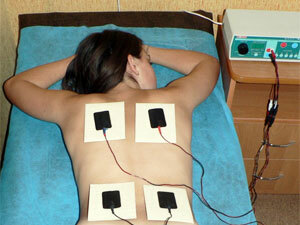 Paresthesia is a condition in which burning, tingling, and crawling of the goosebumps occur. This phenomenon is associated with loss of sensitivity, which can occur due to pinching and damage to peripheral nerves, spinal cord or brain.
Paresthesia is a condition in which burning, tingling, and crawling of the goosebumps occur. This phenomenon is associated with loss of sensitivity, which can occur due to pinching and damage to peripheral nerves, spinal cord or brain.
Paresthesia is not a primary disease. It develops as a symptom in various diseases. Such a phenomenon can also appear as a result of metabolic disorders, poisoning, disturbed blood supply to nerves, and so on.
Many people have often experienced temporary paresthesia when squeezing individual parts of the body, which is also accompanied by numbness. Pathological paresthesia, present constantly or appearing periodically, develops solely as a result of the appearance of primary diseases.
Contents
- Cockles all over the body. ..
- Cockles all over the body. ..
- Causal complex
- Language on the cheeks - bloopy-bloop
- If the legs are "ripped off"
- Hand wars
- Fingerprints
- Lips seem not to be. ..
- When goose bumps all over the head
- Clinical features
- diagnosis
- How to get rid of unpleasant symptoms
- Applied methods
- Complexities of therapy
- Complications and prevention
Shivers all over the body. ..
The main feature is that it"Goose bumps" can be localized in different places. This is influenced by the cause of the appearance of the phenomenon and the peculiarities of the course of the primary disease.
Most often, paresthesia affects the following parts of the body:
- hands;

- feet;
- fingers and toes;
- lips;
- language;
- head.
Some patients of dental clinics face temporary paresthesia localizing in the jaw region, cheeks of the tongue or pharynx.
The decrease in sensitivity may result from improper treatment or removal of the tooth. A dentist can hook or damage a nerve fiber. Usually the phenomenon passes independently for several days. Sometimes, repeated treatment is required.
Causal complex
There are various causes of paresthesia, ranging from pinching of nerves and neurological diseases and ending with toxic poisonings and chronic ailments. Usually, the causes and the place of manifestation of the phenomenon are interrelated.
Language on the cheeks - bloop-bloat
 Numbness and paresthesia of the tongue, as well as a decrease in sensitivity and the lack of the ability to distinguish between tastes occurs under the influence of external factors, neurological abnormalities and due to internal disorders in the work of the body.
Numbness and paresthesia of the tongue, as well as a decrease in sensitivity and the lack of the ability to distinguish between tastes occurs under the influence of external factors, neurological abnormalities and due to internal disorders in the work of the body.
The most common tingling and burning in the tongue results from the development of the following pathologies:
- concomitant disease of the nervous system;
- disorders in the digestive tract;
- cardiovascular diseases;
- disease of the endocrine system and so on.
In addition, the phenomenon may arise due to a lack of vitamin B or mechanical damage to tissues with teeth or artificial dental structures.
If the "legs" are "removed"
Paresthesia of the extremities may be due to the following factors:
- spinal cord injury localized in the lumbar region or below, usually the patient also faces other
 with unpleasant symptoms: decreased sensitivity, weakness, pain, impaired motor function and so on;
with unpleasant symptoms: decreased sensitivity, weakness, pain, impaired motor function and so on; - surgery , which was performed on the spinal cord, spinal nerves or spinal column;
- tumors on the spinal cord ( nerve endings can be clamped, blood supply of nerve fibers and spinal cord is also impaired);
- multiple sclerosis , especially in cases where its foci are localized in the parietal part of the brain;
- polyneuropathy caused by medication, alcoholic beverages or chemical poisoning.
- Reynaud's disease ;
- blood pressure abnormalities in the lower limbs of the .
Hand wars
Unpleasant sensations in the hands can occur in the presence of the following pathologies:
- osteochondrosis ( with the destruction of intervertebral discs, the nerve endings are jammed);
- lesion of individual nerves in the neck region of the inflammatory process;
- is a disorder in the functioning of the blood vessels of the , which supply the brain( sometimes paresthesia is one of the first signs of a stroke);
- Multiple Sclerosis ;
- inflammation of the neck muscles ;
- decrease in the level of calcium in the body .
If excessive alcohol consumption, some infectious diseases, diabetes and intoxication can cause damage to nerve fibers. As a result of the development of pathology, paresthesia in the hands may occur, as one of the symptoms.
Finger sensitivity disorder
Often the phenomenon occurs only on the fingers( hands or feet).The causes of this phenomenon usually do not differ from the causes that cause paresthesia in the hands or feet. It can be:
- osteochondrosis;

- spinal cord injury;
- alcohol or other poisoning;
- Raynaud's disease;
- vitamin B vitamin deficiency;
- lack of calcium and other microelements.
Lips do not seem to be. ..
Tingling, burning or crawling in the lips may result from neurological or other diseases. Among the most common causes it is worth noting:
- neuritis of the facial nerve;
- cervical osteochondrosis;
- Multiple Sclerosis;
- hypertensive crisis( a sharp increase in blood pressure is also accompanied by shortness of breath, severe headache, vomiting, loss of consciousness and other symptoms);
- lack of vitamin B;
- decrease in glucose.
When goose bumps all over the head
The paresthesia of the entire head can cause neurological disorders. The most common causes include:
- of the neuralgia of the facial nerve;
- neuralgia of the triple nerve;
- Bell's palsy;
- transient ischemic attack.
 Sometimes the phenomenon appears before a migraine attack.
Sometimes the phenomenon appears before a migraine attack.
Paresthesia can be a side effect of individual drugs.
The phenomenon can trigger medication to lower blood pressure and anti-relapse drugs, as well as some other remedies.
Features of the clinical picture
Paresthesia is manifested by a decrease in sensitivity, in which unusual sensations arise. The patient feels a tingling, a slight burning sensation on the skin, and crawling.
The main feature is that such a feeling a person experiences when there are different electrical impulses in nerve fibers( or one fiber) that transmit information to the brain.
This happens most often due to disorders in the nervous system.
Diagnosis of
With prolonged or frequent paresthesia, it is necessary to consult a neurologist. After collecting anamnesis and a detailed questioning of the patient( complaints, chronic diseases, other symptoms, etc.), the doctor prescribes a series of clinical or instrumental studies that help establish the cause of the development of this phenomenon.
In most cases, the patient is assigned electroneuromyography. When using this study, the passage of electrical impulses along nerve fibers is monitored. The method allows to determine not only the localization, but the degree of disruption of the passage of nerve impulses.
Depending on the accompanying symptoms, the doctor may also prescribe:
- ECG;

- MRI of the brain or spinal cord;
- heart ultrasound;
- radiography of the spine;
- blood test for toxins;
- EEG;
- dopplerography of vessels and so on.
Complete examination allows you to determine the cause of the violation and to prescribe the correct treatment.
How to get rid of the unpleasant symptoms of
The treatment regimen is directly related to the disease or pathology that causes paresthesia. The main goals of therapy is to eliminate the irritating factor, as well as restore the work of the nervous system and blood supply.
Among the main goals is also to note the stimulation of transmission of nerve impulses on the affected area.
Applied methods
Treatment of paresthesia depends on the location and the cause:
- In case of tingling and burning of the skin as a result of the appearance of , is recommended for surgical intervention.
- If the is damaged in the peripheral nerves or the spinal cord or brain is damaged, the therapeutic actions are aimed at restoring the working capacity( taking medications and prescribing procedures depends on each case).
- When diabetes mellitus , the patient takes medication to resume normal blood glucose levels. In the case of metabolic disorders, medications can also be prescribed.
- When the nerve endings of are squeezed, the therapeutic actions are aimed at eliminating the problem. In the case of a lack of vitamin B or trace elements, a special diet and vitamin complexes are prescribed.
High efficiency in the treatment of neurological diseases is indicated by physiotherapeutic procedures. The doctor can prescribe: 
- electrophoresis;
- acupuncture;
- diadynamic currents;
- magnetotherapy;
- mud treatment and other procedures.
Physiotherapy procedures help to restore normal transmission of electrical impulses, which helps get rid of unpleasant numbness and tingling.
Difficulties of therapy
It is not always possible for the doctor to establish the cause of the phenomenon immediately, which delayed the appointment of the right treatment. In addition, it should be noted that in most cases paresthesia is associated with impairments in nerve fibers, spinal cord or brain.
 Restoration of the components of the nervous system requires a special approach, and it is not always possible in its entirety. In some cases, surgical intervention( tumor, pinching, etc.) is required.
Restoration of the components of the nervous system requires a special approach, and it is not always possible in its entirety. In some cases, surgical intervention( tumor, pinching, etc.) is required.
Sometimes, the disease, the symptom of which is paresthesia, is rapidly developing and can lead to sad consequences. This is why when a repeated phenomenon occurs it is necessary to consult a doctor.
Therapy of paresthesia with neuroses is complicated by excessive irritability and excitability of the patient. In this case, treatment is carried out in a complex way, and includes the use of medications, physical procedures and other methods.
Complications and prophylaxis
Depending on the cause, paresthesia can lead to serious complications:
- paralysis;
- atrophy of the limbs;
- numbness of tissues.
With repeated or prolonged tingling or crawling, it is necessary to contact a neurologist for examination and to determine the cause of this phenomenon.
A good prevention of this and other violations will be: 
- proper nutrition;
- moderate physical activity;
- timely treatment of any pathological processes in the body;
- blood pressure monitoring;
- rejection of bad habits.
Paresthesia itself does not pose a danger to the body. But discomfort can indicate the development of serious diseases and disorders of the nervous system, so do not delay the visit to the doctor.



